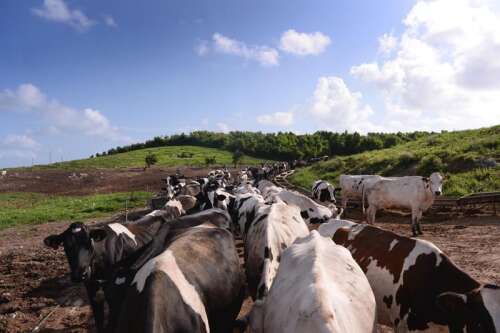By Akil Simmons
Copyright royalgazette

Whenever we are faced with empty shelves in the supermarkets, we are reminded how vulnerable we are when valuable sources of food run out. Earlier this year it was eggs; sometimes it’s carrots, bananas and fresh meat. Most recently, it was fresh milk. Thankfully, there are now alternatives such as Dunkley’s filled milk and a variety of imported, lactose-free options. But what if this isn’t always the case? What if a political or environmental crisis prevents the container ships from leaving the United States?
In reading about the issues faced by Green Land Farm, which supplies the majority of Bermuda’s fresh milk, I can’t help but feel a sense of déjà vu. Every summer, there seems to be a milk shortage, and the overwhelming stench of manure has affected residents in Smith’s for several years now. Whenever it rains, a slurry of faeces pours on to the Store Hill area of the Railway Trail, as well as into some neighbouring properties. Every now and then, an article appears in this newspaper about animal welfare concerns within our dairy herds — and, last year, a member of the public even reported finding dead heifers at Spittal Pond.
What is the Government doing about this? What exactly was wrong with the milk quality at Green Land Farm recently? Who is paying for the clean-up when the manure spills out of the farm?
The decline of our dairy industry has been a long-running concern, which successive governments have failed to address with any meaningful action.
Nearly ten years ago, in June 2016, a Bermuda Dairy Industry Strategy was published. This acknowledged that there had been a 30 per cent decline in output from Bermuda’s dairy farms between 2007 and 2015, but it declared that: “The trend can be reversed with a partnership of government and dairy farmers as outlined in this strategy”. It also proclaimed that the “implementation of more cost-efficient production methods, increased production and product diversification will build a sustainable dairy sector over the next five to ten years”.
At the time, the Government also said: “Fluid cow’s milk is still widely regarded in the Western world as an important component of the diet, especially for growing children.” The Government should be doing everything in its power to ensure this essential dietary component returns to our shelves safely.
The vision, in 2016, was that “within a decade, Bermuda’s dairy industry will be transformed into one that is more efficient, sustainable and profitable; realising production truer to its potential; less fragile and less dependent on foreign labour, and an industry that represents a larger contributor to Bermuda’s gross domestic product. The dairy industry will be better positioned to withstand the ever-present threat of potential importation of fluid milk”.
That vision has yet to be manifested.
However, in February 2023, the Deputy Premier and Minister of Home Affairs, Walter Roban, gave speeches about the creation of an Integrated Agriculture Strategy, citing the “critical need to improve Bermuda’s food and nutritional security by developing and supporting a vibrant local agriculture sector”.
He then committed to advancing six key components “over the next year”, including a crop strategy, a livestock/poultry strategy and, particularly relevant at this moment in time, a dairy strategy. In his 2024 update, no mention was made about any of these strategies, and ministers have been silent on the dairy strategy ever since.
What we deserve to know now is:
• Where is this dairy strategy?
• Who is involved and ultimately responsible for its development and implementation?
• Which local dairy experts have been consulted?
While our requests for updates have gone unanswered, Bermuda’s largest dairy farm was issued a notice of temporary suspension, and residents were unable to buy fresh milk.
With so little apparent interest from the Government, this leads us to ask:
• Does it even want Bermuda to have its own dairy industry?
• Is our island large enough to supply enough milk while maintaining adequate animal welfare standards?
• What are the facts about the health of our cows?
• What are the facts about the quality of our milk?
• Should they repeal the Importation of Milk (Prohibition) Act 1997, to ensure a more reliable source of fresh milk, as recently suggested by retailers?
We deserve detailed answers to this continuing problem.
We would also like to better understand why, until relatively recently, the issues that plague our dairy industry were not as much of a problem. It seems that the persistent neglect of the industry by the Department of Environment and Natural Resources, and the Department of Health, under various government administrations has resulted in the serious challenges it faces.
Another of the challenges is that not enough land has been allocated for dairy herds. Experts tell me that pastures could hold three to five cows per acre, but this is at optimal levels and on the assumption of good-quality grazing. How many dairy cows are there per acre in Bermuda? How much of their food has to be imported? What is the quality of the grass for their grazing? What is the feed-to-milk ratio? Could more land be used to make fodder and silage, thus reducing dairy farmers’ reliance on expensive, imported feed?
We are also increasingly concerned that animal welfare standards are not being upheld within the dairy herds. Summer milk shortages, for example, are blamed on the heat, but a veterinarian we spoke to confirmed that this does not have to be an issue. The issue is correct management. Sufficient shade, they said, could solve this problem, and the Public Health (Milk and Dairy Farm) Regulations 1952 stipulate that “all cowsheds and stalls shall be constructed in such manner as to provide adequate protection against heat and cold.”
The vet also emphasised that the correct management of faeces is also crucial and could solve the persistent smell in the Store Hill area of Smith’s, as well as improve cattle living conditions and their comfort.
In the Netherlands, for example, the laws governing dairy cows are not only strict, but strictly enforced. Faeces are put into vats, which are emptied regularly and used to enrich the fields. What facilities do Bermuda’s dairy farms have in place to handle manure? How often are they emptied? Are intensive dairy operations appropriate for a residential area? Their experience is also that smaller herds produced far more milk, which is attributed to high-quality cow comfort.
Furthermore, why were five dead cows dumped at Marsh Folly in February 2024 and then 18 more in March 2024? Were autopsies done? Were they sick? By law, any infected animal needs to be reported. Where is the public information? Whatever the reality might be, this damages the public perception of Bermuda’s dairy industry.
All of these issues need to be addressed in the Integrated Agriculture Strategy.
As if all of the above is not enough, another issue threatening our dairy industry is that not enough young people want to go into dairy farming. Once this present generation of dairy farmers retires, who will take over the farms? Where are the incentives to enter the industry? What about training programmes and apprenticeship schemes? What happened to the aforementioned partnership with the Government?
Our dairy industry is on the brink. We cannot rely on our local dairy herds for our food security. Some may ask the ultimate question: does Bermuda need its dairy industry at all?
• Kim J. Smith is the executive director of the Bermuda Environmental Sustainability Taskforce



